Bathroom Design Inspiration: A Comprehensive Exploration
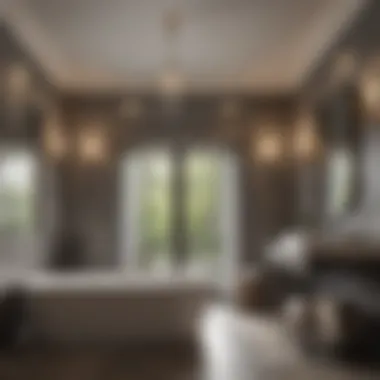
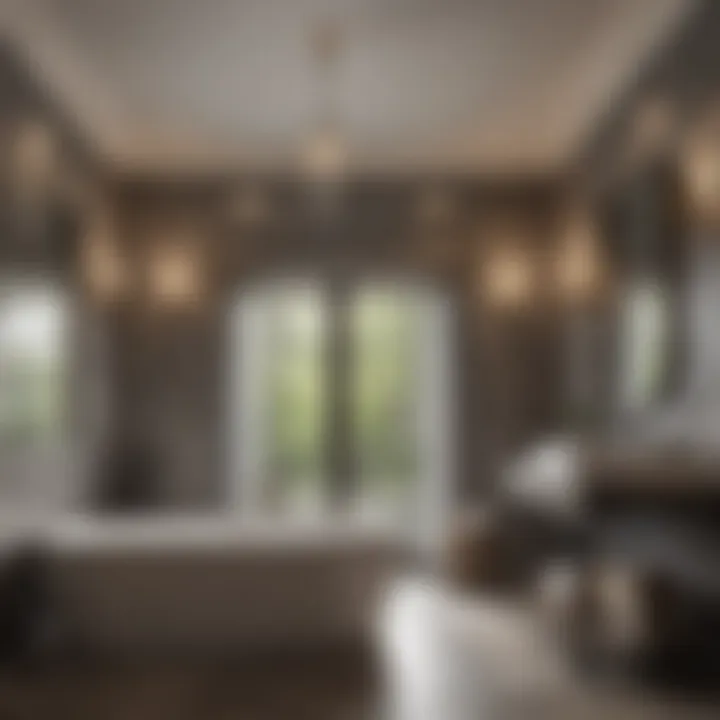
Intro
Creating a beautiful bathroom goes beyond mere functionality. It is a space where comfort and design should coexist harmoniously. A well-designed bathroom cultivates a sense of peace, allowing one to unwind after a long day. Thus, exploring various inspirations for bathroom design becomes essential for making informed choices.
In this exploration, different facets of bathroom aesthetics and functionality will be examined. What’s trending in bathroom design? What materials and colors can transform a space? These questions are pertinent to anyone looking to rejuvenate their bathroom. This guide aims to provide clarity on these aspects, ensuring that every homeowner can curate a personal haven.
A comprehensive focus on common themes, styles, and practical recommendations will aid in enhancing your understanding of bathroom design. Whether you are nuances of contemporary elegance or rustic charm, insights will be shared to help you create a truly inspiring space.
Design Inspirations
Trending Styles
The landscape of bathroom design is continually evolving. Homeowners today enjoy a wealth of options that span various styles. The key trends that are dominating interior design maximize space, enhance light, and offer a touch of elegance. Some of the most popular styles you might consider include:
- Minimalist: Focuses on clean lines and uncluttered spaces. This style emphasizes simplicity with functional elements.
- Industrial: Features raw materials, such as metal and wood. This style often showcases piping and natural textures.
- Spa-inspired: Aims to recreate a tranquil atmosphere that you would find in a luxurious spa. This includes greenery, soft lighting, and calming colors.
- Traditional: Blends classic charm with modern comforts. Here, intricate details meet graceful furnishings.
Embracing a specific style can ground the design of your bathroom and dictate choices around materials, fixtures, and layout.
Color Palettes
The color scheme chosen can significantly influence the mood of a bathroom. Subtle hues have become popular in recent years, as they provide a soothing backdrop. Here are some current palettes to consider:
- Soft Neutrals: Whites, beiges, and grays create a soothing environment.
- Pastels: Light blues and soft greens evoke feelings of calm and serenity.
- Bold Contrasts: Dark tiles paired with light fixtures to create striking visual interest.
When considering colors, factor in lighting. Natural and artificial light can change the appearance of colors, and testing samples in different light conditions can aid in selection.
"Choosing the right colors can add depth and emotion to your space."
Product Recommendations
Bath Accessories
To elevate the functionality as well as aesthetics of your bathroom, selecting the right accessories is vital. Here are essential products to consider:
- Towel Holders: Opt for sleek designs that contribute to a tidy look.
- Soap Dispensers: Choose ones that complement your design style and offer convenience.
- Shower Mats: They should be both functional and visually appealing.
Including these accessories can enhance your overall theme and provide everyday usability.
Fixture Selection
Fixtures are often the focal point in bathroom design. Think about:
- Faucets: Consider modern finishes like matte black or polished chrome.
- Shower Heads: Consider rainfall or handheld styles for functionality and luxury.
- Lighting: Fixtures should harmonize with the overall aesthetic while providing adequate lighting.
Current Trends in Bathroom Design
Current trends in bathroom design play a crucial role in shaping how homeowners envision their personal spaces. As the bathroom evolves from merely a functional area to an essential sanctuary, understanding these trends is indispensable for anyone looking to enhance both utility and aesthetics. The integration of style with practical elements matters. This ensures that a bathroom meets not just personal tastes, but also modern needs for comfort and efficiency.
Minimalism Meets Functionality
The minimalism trend emphasizes clean lines and uncluttered spaces. It appeals to those who seek simplicity and order. Minimalist designs prioritize essential features without unnecessary embellishments, allowing the bathroom to exude calmness. Fixtures are chosen for their functionality, often blending seamlessly with the surrounding design.
Such a space often includes:
- Floating vanities: These create a sense of openness, making the room look larger.
- Concealed storage: This reduces visual clutter, keeping essential items tucked away.
- Neutral colors: White, gray, and black palettes dominate to maintain a serene atmosphere.
Nature-Inspired Interiors
Nature-inspired designs bring the outdoors inside. This trend reflects a growing desire for tranquility and a connection to natural elements. Using materials such as wood, stone, and plants creates a refreshing ambiance.
Benefits of this approach include:
- Biophilic design: Integrating nature promotes wellness. Plants not only add beauty but can also improve air quality.
- Natural materials: Stone tiles and wooden accents lend warmth and texture, enhancing visual appeal.
- Earthy color tones: Greens and browns evoke a sense of peace and grounding, reminiscent of natural landscapes.
Bold Colors and Patterns
In contrast to minimalism, bold colors and patterns are gaining traction. This trend emphasizes personality and creativity. Homeowners are using eye-catching hues and striking patterns to transform their bathrooms into unique reflections of themselves.
Highlights of this trend include:
- Accent walls: A vibrant color or an intricate tile pattern can become a focal point.
- Statement fixtures: Sinks, bathtubs, or taps in bold colors or unusual shapes command attention.
- Eclectic decor: Mixing patterns through wallpapers, towels, and rugs can create a dynamic, personalized space.
This comprehensive exploration of trends informs the decision-making process. With a keen understanding of these elements, homeowners can create a bathroom that embodies both functionality and aesthetic appeal.
Design Elements That Define Space


The design elements present in a bathroom play a crucial role in how the space is perceived and used. Each component contributes not only to the visual appeal but also enhances the overall functionality. Homeowners should pay attention to these elements as they directly influence both comfort and utility in what is often considered one of the most private areas of a home. By carefully choosing specific items within this category, it is possible to create a space that is both aesthetically pleasing and practical.
Vanities and Sink Designs
Vanities are more than just furniture; they are central to a bathroom's overall layout and style. A well-selected vanity can offer ample storage while also serving as a key aesthetic piece. Options range from wall-mounted designs to freestanding models, each providing distinct advantages. Wall-mounted vanities free up floor space and make smaller bathrooms feel larger. In contrast, freestanding units can bring a classic touch. When selecting sink designs, homeowners need to consider both form and function. Undermount sinks, vessel sinks, and console sinks all present unique benefits. For instance, vessel sinks can act as a striking focal point while also being easily accessible.
Shower and Bathtub Choices
The selection between a shower and a bathtub can significantly define the space. This choice often depends on personal preference and lifestyle needs. Showers can save space, especially in smaller bathrooms, and modern designs often include large glass enclosures that enhance the feeling of openness. Conversely, bathtubs can provide an unparalleled sense of relaxation, serving as a luxurious retreat. Combining both in a bathroom is an option for more spacious layouts, permitting a seamless experience between practicality and indulgence. When picking styles, homeowners should explore various shapes, such as freestanding tubs for a contemporary look or traditional drop-in models for a classic feel.
Lighting as a Key Feature
Lighting is a commonly overlooked but essential element in bathroom design. Adequate lighting can transform a functional space into a warm and inviting environment. Considerations include ambient lighting, task lighting, and accent lighting. Ambient lighting creates a general illumination level, while task lighting focuses on specific areas such as vanities or showers. Installing several light sources at different heights can prevent shadows and ensure that the entire space feels balanced. Using dimmable lights can also add an element of versatility. Choosing fixtures that match the overall style can further integrate lighting into the design theme.
Storage Solutions for Clutter-Free Spaces
Efficient storage is vital in maintaining an organized bathroom. Clutter can quickly detract from the overall aesthetic and functionality of the space. Therefore, selecting the right storage solutions is crucial. Options include built-in shelves, cabinets, and innovative organizers. Vanities with drawers facilitate easy access to daily essentials while hiding away larger items. Open shelving can be used for decorative purposes, adding a personal touch while still being functional. Using bins or containers can assist in keeping smaller items organized.
"The key to a successful bathroom design lies in balancing functionality with aesthetics."
Color Schemes and Aesthetics
Color schemes and aesthetics play a crucial role in bathroom design. They are foundational elements that impact not just the visual appeal but also the overall experience within the space. Choosing appropriate colors can create moods that range from tranquil to invigorating. A well-thought-out color scheme helps in defining the character of the bathroom, enhancing both its utility and aesthetic quality. This section will explore the significance of color choices in bathrooms, focusing on neutral palettes and the use of accent colors.
Neutral Palettes for Timeless Looks
Neutral palettes serve as a classic choice for bathroom design. They include shades like white, beige, gray, and taupe. These colors have the ability to create a serene environment that promotes relaxation. Neutral shades provide a backdrop that allows other elements of the space to shine. For instance, fixtures, tiles, and accessories often stand out more without the distraction of bold colors.
These palettes are versatile; they adapt easily to changing trends. Homeowners can update their accessories or fixtures without facing the challenge of repainting or shifting larger design elements. Moreover, neutral colors enhance the feeling of spaciousness, making even small bathrooms appear larger.
Opting for a neutral color scheme also offers practical benefits. Lighter hues reflect light, aiding in illumination—a key factor in any bathroom. Furthermore, neutral palettes tend to have less visual noise, which is essential in creating a peaceful atmosphere. In summary, neutral tones not only capture timeless elegance but also function well in everyday use.
Accent Colors for a Vibrant Touch
While neutral bases provide stability, introducing accent colors can inject energy and personality into a bathroom. Accent colors can be chosen based on personal taste and current trends. Popular choices include deep blues, rich greens, or vibrant yellows. Such hues work well in smaller doses. For instance, using these colors in accessories like towels and artwork adds vibrancy without overwhelming the space.
Typically, these colors are applied to elements that catch the eye, such as bath mats, shower curtains, or even a single feature wall. One effective strategy is to consider color psychology. For example, blue often evokes feelings of calmness, making it suitable for a space dedicated to relaxation. Likewise, warm tones like coral can create a cozy ambiance.
To implement this approach thoughtfully, homeowners can create a color wheel. This visual representation helps in understanding how colors interact with one another.
"A carefully selected accent color can transform an ordinary bathroom into a reflective and personal retreat."
Materials and Finishes
Materials and finishes play a pivotal role in bathroom design, not just for aesthetics but also for functionality and maintenance. Selecting the right materials can significantly affect the longevity and usability of the space. The combination of various finishes can create a harmonious environment that reflects personal style while catering to practical needs.
Durability is paramount in a bathroom where moisture levels fluctuate. When materials are chosen wisely, they withstand humidity, stains, and wear. Some popular materials not only serve their purpose but can elevate the overall look of the space. While aesthetics matter, one must also consider ease of cleaning and maintenance. Choosing finishes that are simpler to maintain without compromising on style contributes to making the bathroom both beautiful and functional.
Choosing the Right Tiles
Tiles are among the most versatile materials available in bathroom design. They come in various shapes, sizes, colors, and patterns, allowing for endless creativity. The choice of tile can dictate the overall atmosphere of the room. For example, large tiles can make a small space feel bigger, while mosaic tiles can add texture and interest.
When selecting tiles, consider factors like slip resistance, water absorption, and ease of installation. Porcelain and ceramic tiles are widely popular due to their durability and low water absorption rates. They offer a wide variety of design options while effortlessly combating the challenges posed by moisture.
"The right tile can completely transform a bathroom, making it feel more luxurious without breaking the bank."
The Role of Natural Stone
Natural stone provides a unique charm to bathroom spaces. Materials such as marble, granite, and limestone can bring an element of elegance. They are available in various finishes and can be customized for any project. One significant benefit of using natural stone is its uniqueness; each piece is distinct, contributing to a one-of-a-kind look.
However, there are essential considerations. Natural stones typically require regular sealing to protect against staining and moisture absorption. Understanding the characteristics of each stone type is crucial to prevent potential issues in future maintenance. While the initial cost may be higher, investing in quality natural stone can lead to long-lasting beauty and durability.
Sustainable Materials for Eco-Conscious Design
In an age where sustainability is becoming a priority, incorporating eco-friendly materials into bathroom design is essential. Materials like bamboo, recycled glass, and sustainably sourced wood are excellent options. These choices not only minimize environmental impact but also infuse a sense of nature into the decor.
Choosing sustainable materials often leads to healthier indoor air quality. Many eco-friendly products come without harmful chemicals often found in conventional materials. Moreover, sustainable materials can be just as aesthetically pleasing as traditional options. Homeowners can achieve their design vision while also being mindful of their ecological footprint.
Combining Functionality with Style
The concept of combining functionality with style is crucial in modern bathroom design. A bathroom is not just a utility space; it serves as a sanctuary for relaxation and rejuvenation. By seamlessly blending practical features with aesthetic appeal, homeowners can create an environment that is both efficient and pleasing to the eye. This balance is essential for enhancing the everyday experience of users while also adding value to the home.
Ergonomic Design Principles
Ergonomics plays an integral role in bathroom design. It focuses on creating spaces that prioritize user comfort and efficiency. Consider the height of vanities. A vanity that is too low or too high can create discomfort during use. An ideal height caters to the average height of users in the household.
Storage is another element influenced by ergonomic design. Cabinets and shelves should be easily accessible, reducing the need for awkward bending or reaching.
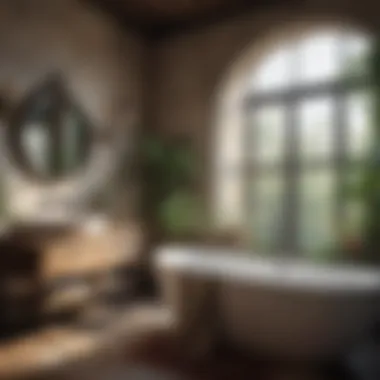
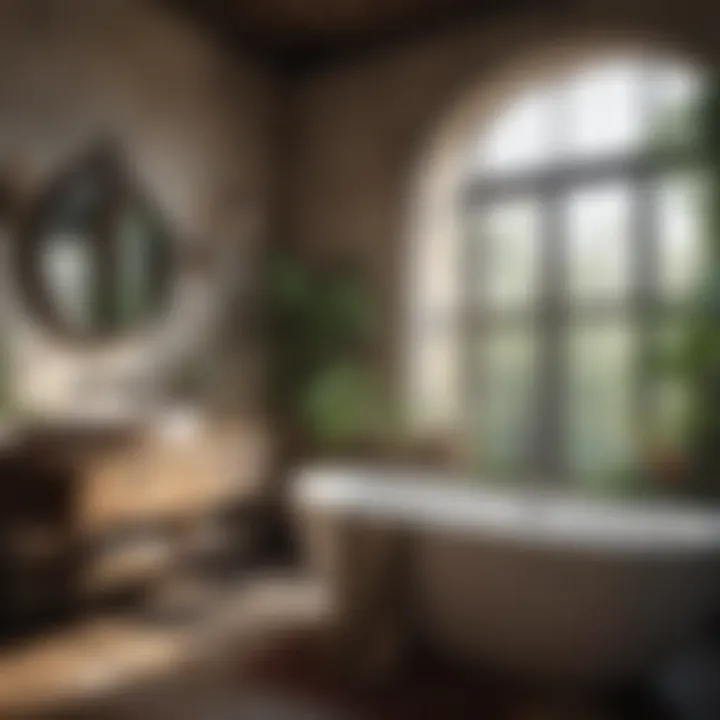
- Utilize pull-out drawers that make reaching items simple.
- Implement shelves at varying heights to accommodate different needs.
Additionally, the layout of fixtures should accommodate the natural flow of movement. Sinks, toilets, and showers should be arranged to allow easy access without obstruction. Ergonomic principles ensure that the bathroom is not just functional but also promotes a user-friendly experience.
Water Efficiency and Smart Fixtures
As water conservation becomes increasingly important, the choice of fixtures in bathroom design reflects a shift towards efficiency. Smart fixtures, such as low-flow toilets and touchless faucets, contribute to significant water savings. They serve functional needs while integrating technology into everyday tasks.
- Intelligent water management systems can automatically adjust flow rates based on usage, minimizing waste.
- Water-efficient showerheads reduce consumption without compromising shower quality.
In addition to conserving resources, smart fixtures enhance the style of a bathroom. Options like motion-sensor taps or digital showers can become focal points, demonstrating the homeowner's commitment to modern technology and sustainability.
By integrating smart technology, homeowners not only address efficiency but also enhance the overall design aesthetic of their bathroom.
Combining functionality with style is essential in bathroom design. It ensures that every element serves a purpose, while also contributing to an inviting atmosphere. Proper ergonomic principles and the inclusion of smart fixtures are vital in achieving this delicate balance.
Personal Touches and Accessories
Adding personal touches and accessories to bathroom design is essential in creating a space that resonates with individuality and comfort. The bathroom, often seen as a purely functional area, can transform into a serene retreat with thoughtful decorations and personal items. Incorporating these elements allows homeowners to express their unique style while enhancing the overall ambiance of the room.
Art and Decor Elements
Art plays a significant role in defining the character of a bathroom. The choice of wall art, sculptures, or decorative accents can evoke certain feelings and set a tone. Many opt for vibrant paintings or soothing landscapes that complement the color palette of the bathroom. Choosing pieces that reflect personal interests or travel memories adds more meaning to the space.
- Types of Articular Decor
a. Framed Prints: Simple yet effective, these can easily enhance a plain wall.
b. Mirrors: Decorative mirrors not only serve a functional purpose but also act as art pieces themselves. A uniquely shaped mirror can create a focal point. c. Wall Hangings: Textile arts or handmade crafts can introduce texture and warmth into a bathroom.
Using decor to personalize the space can contribute not only to aesthetics but also to emotional well-being. After all, a bathroom should be a comforting area where one can unwind after a long day.
Textiles and Color Coordination
Textiles in a bathroom, such as towels, rugs, and curtains, are vital to maintaining comfort and warmth. These elements bring softness to what is often a collection of hard surfaces. Color coordination among these accessories can either create a cohesive look or introduce playful contrasts.
Carefully selected color schemes help evoke desired moods and can make the space feel larger or more intimate. Choosing neutral tones sets a calming backdrop, while bold colors can invigorate the room.
- Texture Selection: Different textures can elevate the feeling of luxury. Consider plush towels or soft rugs to amplify comfort.
- Layering for Depth: Mixing different textiles can enhance the aesthetic. For example, a patterned shower curtain can be paired with solid color towels for balance.
By integrating these personal touches and accessories, one creates a bathroom that is not only beautiful but also functional and reflective of personal tastes.
Lighting Strategies for Bathrooms
Lighting is a critical element in bathroom design. It affects both the functionality and ambiance of the space. The right lighting can enhance the overall aesthetic, support daily tasks like grooming, and create a serene environment for relaxation. Furthermore, well-planned lighting strategies can make a small bathroom feel larger and more welcoming.
Understanding different lighting layers and fixtures is essential. Each type serves a specific purpose, ensuring that the space is not only beautiful but also practical. Without proper lighting, even the most stylish bathroom can fall short of its potential. The use of layered lighting is particularly beneficial, as it combines ambient, task, and accent lighting to cater to various activities and moods.
Layered Lighting Approaches
Layering lighting in a bathroom means combining three main types: ambient, task, and accent.
- Ambient Lighting: This is the general illumination that fills the space. Ceiling-mounted fixtures or recessed lights can provide effective ambient lighting. It is important to create a soft glow that offers a comfortable atmosphere without being harsh or overwhelming.
- Task Lighting: This lighting is essential for specific functions, such as applying makeup or shaving. Wall sconces near mirrors or bright overhead lights directly above the vanity area are ideal choices. The brightness should be sufficient to illuminate the face and prevent shadows, which is critical for detailed tasks.
- Accent Lighting: This type highlights specific features in the bathroom, such as artwork or architectural elements. Using small spotlights or LED strips can add interest and character to the space.
Incorporating a mix of these lighting elements leads to a balanced approach. This ensures the bathroom is well-lit for all activities while also providing a visually appealing atmosphere.
Innovative Fixture Ideas
Choosing the right fixtures can make a significant difference in both functionality and style. Innovative lighting options transform the bathroom and contribute to overall design coherence.
Unique fixtures to consider include:
- Smart Mirrors: These mirrors often come with built-in LED lighting that can adjust brightness based on ambient light levels. They may also include features like integrated speakers or touch controls, combining several functionalities in one.
- Pendant Lights: Whether over a soaking tub or vanity, pendant lights introduce a sense of elegance. They come in various styles, from contemporary to vintage, allowing for personalization of the bathroom decor.
- Water-Resistant LED Strips: These are perfect for placing under vanities or around mirrors. The flexibility of these strips enables creative placement, providing additional light exactly where it's needed.
- Recessed Lighting with Dimmers: Installing dimmable recessed lights offers flexibility in ambiance. Such fixtures can switch from bright workspace lighting to soft night lighting effortlessly.
In summary, innovative lighting fixtures are essential in modern bathroom design. Combining multiple fixtures can enrich the space visually and functionally, creating a bathroom that serves its purpose with style. By prioritizing both practicality and aesthetics, homeowners can cultivate a truly remarkable bathroom environment.
"Proper lighting not only enhances the beauty of a bathroom but also elevates its functionality, creating a space that is both a sanctuary and a utility."
By understanding the significance of lighting strategies, and their layered approaches, as well as exploring innovative fixture ideas, one can achieve a thoughtfully designed bathroom. This transformation is crucial in making a personal space that reflects individual style while being practical for everyday life.
Practical Considerations for Bathroom Layout
In bathroom design, the layout is a critical aspect that can significantly impact both functionality and aesthetics. The arrangement of various elements within the space contributes to the overall user experience. Focusing on practical considerations can help maximize the efficiency of the bathroom while also ensuring it meets the household's specific needs. A well-planned layout enables seamless movement and enhances the space's usability. Additionally, it is essential to strike a balance between style and practicality, as bathrooms serve not just as functional areas but also as essential sanctuaries for relaxation and self-care.
Maximizing Space in Smaller Bathrooms
When dealing with smaller bathrooms, every inch counts. It becomes crucial to implement design strategies that allow for optimal space usage. Some effective ways to maximize space include:
- Compact Fixtures: Choosing smaller-scale sinks, toilets, and bathtubs can free up precious square footage. Models like the TOTO Aquia or Kohler Veil are good examples of compact options.
- Vertical Storage Solutions: Utilize wall-mounted shelves or cabinets to keep the floor space clear. This opens up the room visually and functionally.
- Mirrored Surfaces: Installing a large mirror can create an illusion of depth. Additionally, mirrors serve as an effective tool for improving lighting in the bathroom.
- Open Shelving: Instead of bulky cabinets, consider using open shelving which can provide storage without overwhelming the space. It allows for easy access to frequently used items while adding a personal touch to the decor.
- Light Colors and Materials: Opting for light colors on walls and cabinetry can make a small bathroom feel larger. White or soft pastels can reflect light and enhance brightness.
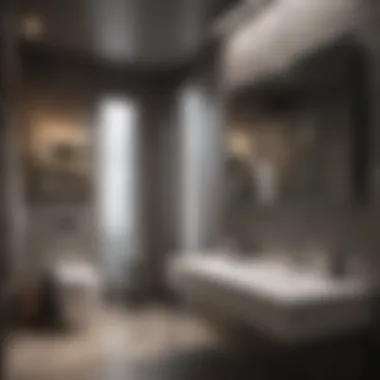
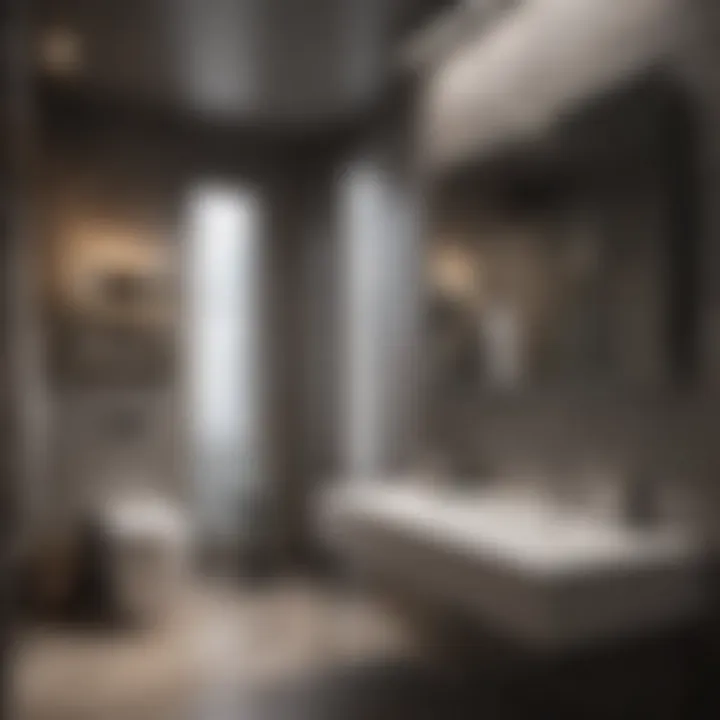
Adopting these strategies ensures that a smaller bathroom remains functional without sacrificing style.
Creating Flow and Functionality
A well-designed bathroom should allow for smooth movement between fixtures, enhancing both comfort and efficiency. To create flow and functionality, consider the following:
- Designate Zones: Establishing clear zones for different activities helps users navigate the space effortlessly. For example, design separate zones for bathing, grooming, and storage.
- Avoid Clutter: Keep countertops and surfaces clear from unnecessary items. A clean, uncluttered space facilitates movement and creates a soothing environment.
- Consider Door Swing: When planning the layout, think about how doors open. Avoid placing fixtures in the way of door swings, which can disrupt flow and usability.
- Use Universal Design Principles: Incorporating universal design helps ensure that the bathroom can be used comfortably by everyone. Wider pathways and accessible fixtures can accommodate various needs, enhancing overall functionality.
"The bathroom must serve well the needs of all who enter. A flow-optimized layout ensures ease of use while enhancing overall satisfaction."
Focusing on these aspects can transform how one interacts with the bathroom space. With careful consideration and strategic planning, any bathroom can achieve a harmonious balance of practicality and comfort.
Trends in Smart Bathroom Technology
Smart bathroom technology has fundamentally transformed how we interact with our private spaces. Embracing these innovations not only enhances convenience but elevates the overall user experience. As bathrooms evolve from merely functional areas to sanctuaries, integrating smart technology can optimize comfort, efficiency, and sustainability.
Intelligent Water Management Systems
Water management plays a critical role in modern bathroom design. Intelligent water management systems offer features like automatic flow control, leak detection, and usage monitoring. By assessing water consumption patterns, these systems allow homeowners to adjust their habits effectively. For example, they can trigger alerts when water usage exceeds normal levels. This not only conserves water but also contributes significantly to reducing utility expenses.
The aspect of eco-friendliness cannot be overstated. Systems that integrate with existing faucets and toilets can be particularly beneficial. They function seamlessly, adjusting water flow to minimize waste without sacrificing performance. Moreover, these systems can be controlled remotely via smartphone apps, enhancing user satisfaction. The ability to monitor water usage in real-time provides users with valuable insights on consumption patterns, empowering them to make informed decisions about their water habits.
Home Automation Features
Home automation features bring an advanced layer of convenience to bathroom spaces. These features allow seamless integration of various devices, creating a synchronized environment. For example, automated lighting systems can adjust brightness according to the time of day or personal preferences. This adaptability not only enhances functionality but also contributes to energy efficiency.
Another significant aspect is the integration of smart mirrors. These mirrors can display relevant information such as weather updates, news, and even personal reminders, all while you prepare for your day. Taps and showers can also be controlled through voice commands or smartphone apps, increasing ease of use in busy households.
Additionally, smart shower systems offer customizable water temperature and pressure settings. Users can program preferences for individual family members, resulting in a personalized experience. These features position your bathroom as more than a practical space, but a tailored haven for relaxation and personal care.
Smart technology in bathrooms is the intersection of luxury and practicality, making everyday routines effortless.
In summary, incorporating trends like intelligent water management systems and home automation features into bathroom design represents a pivotal shift in how these spaces function. The integration of such technologies results in better resource management, personalized experiences, and ultimately, a more enjoyable use of the bathroom. As homeowners consider renovations, prioritizing smart technology becomes a powerful way to enhance both the functionality and aesthetic appeal of these essential spaces.
Emphasizing Wellness in Bathroom Design
In recent years, the concept of wellness has found its way into various aspects of life, including home design. The bathroom, often a private retreat, plays a significant role in promoting well-being. By focusing on creating a serene atmosphere, homeowners can enhance the overall experience within this essential space. Elements that emphasize wellness can range from soothing color schemes to functional design that facilitates relaxation.
When creating a wellness-oriented bathroom, several factors should be considered. These include the selection of materials that promote a calming environment and the integration of features that cater to physical and mental health. The result can transform a merely functional space into a sanctuary for relaxation and recovery.
Incorporating Relaxation Elements
To create a tranquil environment, including various relaxation elements can be highly effective. Features such as soaking tubs, rainfall showerheads, and comfortable seating can elevate the overall experience. Soft, ambient lighting can also play a crucial role in establishing a calm atmosphere. Escaping the routine of daily life often starts in the bathroom.
Essential elements to think about include:
- Soaking Tubs: A deep soaking tub provides a perfect place for unwinding after a long day. It invites long, leisurely baths, enhancing the feeling of escape.
- Rainfall Showerheads: These can mimic the sensation of gentle rain, offering a relaxing experience that invigorates the senses.
- Comfortable Seating: Adding a small stool or bench can create a space for resting and reflection, further promoting relaxation.
"Designing a bathroom that prioritizes wellness involves careful consideration of how each element contributes to relaxation and rejuvenation."
Aromatherapy and Human-Centric Design
Aromatherapy can greatly enhance the wellness aspect of bathroom design. Integrating scents that promote peace and mindfulness can create an immersive experience, calming the mind and body. Essential oils, diffusers, or even scented candles can serve as low-cost options to add olfactory delight to the space.
In conjunction with aromatherapy, human-centric design is essential for creating an environment that acknowledges user needs. This includes features such as adjustable lighting that can shift from bright for tasks to soft for relaxation, as well as smart design principles that take into account the flow of movement within the space.
Ultimately, wellness-focused bathrooms should prioritize both sensory experiences and ease of use, combining elements that support relaxation with thoughtful layouts and accessibility. This approach not only leads to improved well-being but also elevates the daily routine into something more intentional and enjoyable.
The Future of Bathroom Design
As we move further into the 21st century, the future of bathroom design holds significant promise, focusing on thoughtful integration of style, technology, and environmental stewardship. Thermal comfort and personalization are central themes influencing new designs. This section will highlight the key facets shaping the future, covering sustainability, technology, and consumer preferences.
Sustainability Trends
Sustainability is not just a trend; it is becoming a prerequisite in modern bathroom design. Homeowners are increasingly looking to invest in eco-friendly options that minimize environmental impacts. Such choices include water-efficient fixtures and recycling strategies.
- Eco-friendly materials: Utilizing sustainable resources like bamboo or recycled materials enhances not only aesthetics but also the environmental footprint.
- Low-water use fixtures: Showers, toilets, and faucets designed to use less water while maintaining efficiency are gaining traction. Brands like Kohler and Delta are at the forefront with their innovations in this area.
"Choosing sustainable bathroom solutions today creates a healthier living environment for future generations."
- Energy-efficient lighting: Transitioning to LED lights reduces energy consumption. This small change can lead to significant savings over time.
In addition to making individual bathrooms greener, these innovations contribute to larger sustainability goals in residential areas, encouraging communities to rethink water and energy use.
Innovation in Design Practices
The future of bathroom design also relies heavily on design practices that reflect innovation. Many homeowners desire spaces that are functional yet stylish, leading to fresh approaches in design.
- 3D printing: This technology allows for customized fixtures and decor according to personal taste and available space.
- Virtual Reality: VR can be used in planning layouts and choosing materials, helping homeowners visualize their designs before any physical work occurs.
- Smart technology integration: Features like touchless faucets, smart showers, and mirrors that display personal health metrics are becoming commonplace. Technologies from brands like Moen and Hansgrohe support this trend.
Using cutting-edge tools in the design process not only enhances the final product but also saves on waste by ensuring accuracy in measurements and choices. The focus on integration of technology offers immense opportunities for restructuring how bathrooms operate and feel.
Homeowners are now demanding a blend of luxury and practicality. The future will prioritize customization, allowing for truly unique spaces that meet specific needs.



